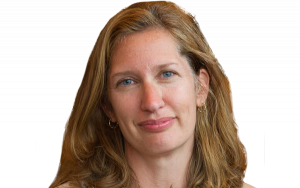Lake & Pillow: Our Schools Can’t Just Serve the ‘Round Peg’ Students. Here’s How We Can Design an Education System for the Tails, Not the Mean

This essay was originally published as part of CRPE’s 25th anniversary collection, Thinking Forward: New Ideas for a New Era of Public Education
The public education system must prepare all students to solve the problems of the future. But for many students, the system is not rising to the challenge.
While high school graduation rates are at an all-time high, completion and dropout statistics for students with disabilities remain dismal. The latest federal education statistics show fewer than two-thirds finished high school with a standard diploma. A fifth either dropped out of school or aged out without receiving a credential. This educational shortfall manifests in the workforce. Less than a third of working-age people with disabilities are employed, compared to 74 percent of people without disabilities. More than 10 million working-age Americans with disabilities are outside the workforce. A growing number of companies are looking for ways to draw on these Americans’ talents.
Chetan Bakhru, a senior accessibility specialist for JPMorgan Chase, recently put it this way: “People with disabilities can represent some of your best talent pool because they have skills that they’ve had to develop throughout their lives, like problem-solving and leadership and time management … There is a very high percentage of people with disabilities who are capable of working but are unemployed simply because of misperceptions or biases.”
Beyond students with disabilities, other student populations have unique needs that existing public school systems remain ill-equipped to meet:
● High-achieving, low-income students often fall behind their peers who have similar abilities but greater economic means. They are less likely to be identified for gifted programs or have access to challenging coursework.
● Students who are not native English speakers often struggle to find high-quality academic programs tailored to their needs.
● The number of American public school students who were homeless rose by more than 38 percent between 2009 and 2014.
● Researchers have estimated that 50 percent of children in foster care drop out of school. College attendance and completion rates for foster children substantially lag behind those of their peers.
● Few jurisdictions have coherent policies designed to meet the unique academic needs of “twice exceptional” learners who may have extraordinary gifts in some areas and require support in others.
The struggles of these students, along with those of countless other “square pegs” — independent thinkers, nonconformists, students who are exceptionally creative — cry out for approaches that can better match talent with opportunity. It’s hard to forecast all the demands the age of agility will place on the next generation, but it’s a safe bet that creative problem-solving, bilingual communication skills, and unconventional thinking will all be in high demand; we cannot afford to throw away these talents. Further, solving for the needs of these complex learners may help the public education system get it right for everyone.
Who are the students on the tails and why do they matter?
At New York City’s Autism Charter School, students with profound communication and academic challenges benefit from a radically personalized education. Each receives personalized job training, individualized academic goals, supports, and motivators tailored to their interests — all aligned with community partnerships and intensive communication and coordination with family members.
Imagine if every student had a similarly tailored experience
Most public school districts and schools will readily admit that they don’t know what to do with the most complex students. Special education works in some cases, but too often does not. Teachers are trained to address generic categorical needs such as “ADHD” or “gifted,” but not to look for individualized solutions. The participation of low-income students and students of color in gifted programs is disproportionately low. While intelligence is randomly distributed, opportunity is not.
A growing effort to personalize learning moves in the right direction, but is not enough. These efforts are largely focused on a broad attempt to better differentiate instruction in a classroom or to allow students to express more personal agency over their learning. Students at the extreme are generally still forced to try to fit in classrooms or schools that can’t accommodate their differences. These kids need more than just to move ahead in an online math program or participate in project-based learning. These students need flexibility and options. They need interactions with adults and peers who “get” them. They need a responsive and sophisticated set of supports that can be customized to who they are at any given developmental stage. They need an education system that recognizes these needs and is determined to help them realize their individual potential.
What if we turned things upside down and designed the system for them?
New programs and new supports within the current system will not accomplish what we’re talking about. School district bureaucracies are designed for sameness, not individualized approaches, and can rarely adapt to meet the needs of every student. The NYC Autism Charter School tried to get the division of the New York City Department of Education that provides special education to adopt its approach, but its efforts fell apart because of teacher certification and training requirements, lack of common planning time, and other factors that, as a public charter school, the NYC Autism Charter School had greater flexibility over.
Staffing constraints and rules limit the accommodations schools are able to offer students who don’t fit neatly into a diagnosis or other service category. It often isn’t feasible to keep a full complement of social workers, school psychologists, speech and occupational therapists, or behavior specialists on staff to accommodate the full range of conceivable needs complex learners may have.
At the same time, therapies and social services within schools are often narrowly focused on students’ educational needs. That means they operate in separate silos from the medical and social services employees who work with children outside school, even though their work may naturally overlap. The same occupational therapist who helps a child with impaired motor skills learn to hold a toothbrush could also help them learn to hold a pencil. The same mental health counselor who helps a child cope with out-of-school trauma could also help them deal with stresses that arise in school.
Schools like the NYC Autism Charter School are cropping up around the country. But because the current education system is so rigid, they often operate as new charter or private schools with the freedom to design educational programs from scratch. Learning from their approaches, and applying their principles more broadly, would lead schools to develop:
● Real choices and multiple pathways for students to find a good fit.
● A focus on student competencies with a commitment to rigor and equity.
● A commitment to addressing social and emotional learning needs in innovative ways.
● A focus on student assets, not deficits.
● New ways of leveraging community assets, including industry, universities, arts, and social services.
School systems may need to rethink everything. Training. Staffing models. Schedules. Student progression. The artificial boundaries that separate schools from community institutions like employers, arts institutions, universities, and social-service providers.
Sometimes, effective learning experiences lie outside the school walls. The North Florida School of Special Education is one of many Florida schools offering a transition-to-work program for older students. They often spend part of the day working for employers like Publix, a local grocery chain. This on-the-job experience helps students hone their soft skills while also helping them earn incomes and prepare for future employment.
The program offers a natural partnership between schools and companies, many of which already participate in supported-employment programs for adults with disabilities. Schools should work to systematically track the skills students acquire from these experiences — and the challenges they encounter — so they can identify gaps in on-the-job learning and interventions designed to address them.
Systemic innovations
Serving every student’s needs, no matter how complex, at scale will require system-level changes, both within school districts and outside them.
Districts could build intentional spaces for experimentation and improvement by giving schools the opportunity to propose innovative new programs for students with complex needs who are not currently being well served. In exchange for more charter-like flexibility over staffing and funds, the schools would have to show results using agreed-upon metrics. Districts and states could support these schools by curating community partnerships, resource banks, talent recruitment efforts, and information to help families with unique needs find a good fit.
The question is why districts have not already done these things, and what might cause that to change.
Bottom-up pressure. Parents and students should have a greater say in shaping learning conditions. They should be made aware of their rights and their options for exercising them. Giving parents and students the authority to petition for more rigorous courses, more inclusive learning environments, or additional accommodations without turning to the courts may help force school systems to find creative ways to serve them better.
Top-down pressure. The gradual relaxation of the federal No Child Left Behind Act’s requirement that schools ensure students from key subgroups — including those with disabilities — make adequate yearly academic progress has reduced incentives for schools to ensure they serve complex learners well. In many cases, accountability systems reward schools that lift students above minimum proficiency thresholds. This drives focus and attention toward the median, rather than toward students on the tails. With new flexibility to design their own accountability systems, the time is ripe for states to experiment with new ways to push schools to improve outcomes for overlooked student groups—while learning from past excesses by, for example, allowing enough time for school systems to try new approaches and giving those approaches a chance to work.
Support for breakthrough initiatives. Districts and charter school authorizers, faced with real pressure from parents and accountability systems, would have to foster new solutions for students whose needs are not currently being met. National and local philanthropies could support the design and startup costs for specialized technology-based tools and curricula for complex learners, as well as for more radically personalized school designs. The next generation of charter management organizations (CMOs) could propose, for example, to run a set of schools that primarily manages student learning portfolios. Rather than providing all of the educational services, the CMO might instead help a student who is both gifted and dyslexic bundle a high-level math class, specialized tutoring, and perhaps a social skills friends group. The CMOs would help provide transportation or bring services to a central location, vet the learning services, and monitor — and be accountable for — the student’s progress. Put simply, the CMO would be designed to “get” every student and follow them throughout their educational progression to create coherence as needs evolve.
Given the opportunity, entrepreneurial educators, parents desperate for new solutions, and students who are complex thinkers surely could come up with many more possible school designs and systemwide solutions. Much like wheelchair ramps, video closed-captioning, and accessible web design were accommodations for special populations that wound up having much more broadly shared benefits, the goal should be an education system that adheres to the principle that a focus on serving exceptional students can ultimately serve all students better.
This work requires changes to policy, many of which will disrupt the status quo
Transforming the system to serve complex learners better may ultimately result in changes that benefit everyone — but also may threaten to disrupt entrenched interests. A public education system designed to serve these students well would include:
Weighted backpack funding. Parents often struggle to obtain appropriate services for their children during the traditional process of developing an Individualized Education Program, or IEP, and the commitments they do get are only as good as a school’s ability to provide them. At the same time, their children’s evaluations also help their schools draw additional funding, both under federal IDEA funding and through state formulas. Families should have the option of using a portion of that money themselves to pay for supplemental therapy or out-of-school or at-home learning experiences, or to supplement medical and social service programs that may affect their child’s ability to perform at school.
Early identification and intervention. Children of color are often misidentified when it comes to special education. And while Child Find systems remain imperfect at identifying children’s special education needs, they are even less well-equipped to identify other issues — gifted eligibility, dual exceptionality, mental health needs — that may affect a student’s success at school. School districts should pilot new methods of assessing students’ needs and developing custom educational pathways and support services.
Navigators. Parents of children with special needs often spend years learning how to advocate for their children, what services are available, and what recourse they have if they don’t get services they feel are necessary. Wealthy parents often hire lawyers or consultants to help them answer these questions or, if necessary, take their schools to court. If every child had a professional advocate to advise parents of their rights and available options, it might help children find better services and reduce costly litigation. Through their work with parents, navigators could also help school system officials identify unmet community needs.
A stronger, provider-agnostic conception of student rights with real potential remedies. Right now, IDEA places an obligation on schools to provide the accommodations called for in an IEP. Parents often must waive those rights if they opt for private alternatives. As more students with special needs participate in workforce training programs, dual-enroll at colleges, or take advantage of education services from a range of providers outside their schools, their right to a free, appropriate public education should not be a take-it-or-leave-it proposition.
Coproduction with parents. Parent involvement is key at schools like the NYC Autism Charter School that cater to the unique needs of complex learners. Studies have found parent literacy programs help improve outcomes for English language learners, even if parents read to their children in their native language.
Revamped accountability designed around learner profiles. Today’s typical state and district school accountability systems are largely incompatible with a system designed to serve every student’s unique needs. Instead, they are designed to measure average student performance at the school or district level, masking individual performance and growth. They also are oriented around grade-level academic expectations that may not be appropriate to a particular student’s capacity and developmental needs. State and local school accountability policies must shift away from tracking average scores and move to tracking individual progress toward mastery. Paul Hill’s essay on local governance explores this idea deeply.
Adequate and flexible funding. Some students are simply more expensive to serve than others. And no matter the amount, if funding is tied up in set programs and central offices, and even in schools, it cannot be used flexibly for individualized courses, community-based programming, and other customized options. Student-based funding, course-based funding, and other flexible ways for funds to follow students all must be on the table.
Together, these changes would put significant pressure on the status quo and may even challenge long-held tenets of some education reformers, such as the idea that the school should be the fundamental unit of change.
It is true that education systems are unlikely to change meaningfully unless students and their families are empowered to craft solutions that best fit their needs. However, schools, government agencies, and nonprofits must also be incentivized — and given the freedom, capacity, and resources — to meet those needs. They must develop new school designs and learning spaces that are unbound from the governance and practices of the past. They must create avenues for families to partner in new ways with educators, industry, higher education, and service providers in their communities. The question is how to achieve those ends without upending the elements of the current system that do work well.
A system that reinvents itself to meet the needs of complex learners would leverage more community assets, give parents more information and control over resources, ensure funding and accountability follow students, and increase parents’ involvement in the development of educational pathways designed to best support their children’s talents and interests. In short, the system would do whatever it takes to maximize a given student’s potential. And it would follow the principle that designing for the most complex and extreme needs ultimately benefits every student.
This essay was originally published as part of CRPE’s 25th anniversary collection, Thinking Forward: New Ideas for a New Era of Public Education
Get stories like these delivered straight to your inbox. Sign up for The 74 Newsletter

;)

